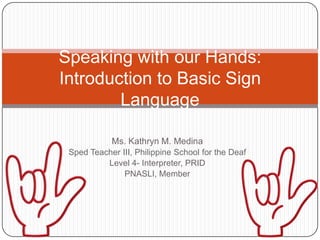Speaking with our hands
- 1. Speaking with our Hands: Introduction to Basic Sign Language Ms. Kathryn M. Medina Sped Teacher III, Philippine School for the Deaf Level 4- Interpreter, PRID PNASLI, Member
- 2. What is Deafness ď‚— Deafness, hearing impairment, or hearing loss is a partial or total inability to hear. ď‚— Hearing loss exists when there is diminished sensitivity to the sounds normally heard ď‚— Deafness is defined as a degree of impairment such that a person is unable to understand speech even in the presence of amplification
- 3. Causes  Age Syndrome  Noise • Neurological  Genetic disorders  Multiple sclerosis  Illness  Stroke  Measles  Medication  Meningitis  Chemicals  Mumps  Head trauma • HIV/ AIDS • Premature birth • Fetal Alcohol
- 4. Level of Deafness ď‚— . Hearing impairment may be ranked as mild, moderate, moderately severe, severe or profound as defined below: ď‚— Mild: ď‚— for adults: between 26 and 40 dB HL ď‚— for children: between 20 and 40 dB HL ď‚— Moderate: between 41 and 54 dB HL ď‚— Moderately severe: between 55 and 70 dB HL ď‚— Severe: between 71 and 90 dB HL ď‚— Profound: 91 dB HL or greater ď‚— Totally Deaf: Have no hearing at all.
- 5. Methods in Communicating with the Deaf ď‚— Communication methods for communicating with deaf and hard of hearng people (and language development) including: ď‚— auditory verbal, ď‚— cued speech, ď‚— sign language, (ASL and /or FSL) ď‚— signed exact english, ď‚— speech therapy, ď‚— speechreading/lipreading, ď‚— and total communication.
- 6. What is Sign Language and how can we use this to our Deaf students / Deaf loved ones? ď‚— We can use the following: ď‚— American Sign Language ď‚— Sign Exact English ď‚— Filipino Sign Language
- 7. Things we have to remember in signing There are five distinct elements to correctly using Sign Language . They are: ď‚— Hand Shape ď‚— Hand Position ď‚— Hand Orientation ď‚— Hand Movement ď‚— Facial Expression
- 8. Let us start Basic Signing!!!
- 11. Now lets try another one!
- 12. Basic Sign Language ď‚— God ď‚— Uncle ď‚— People ď‚— Aunt ď‚— Family ď‚— Cousins ď‚— Father ď‚— Teacher ď‚— Mother ď‚— Principal ď‚— Brother ď‚— Classmates ď‚— Sister ď‚— Grandmother ď‚— Grandfather
- 13.  Happy –glad-  Me  New joy  She  Old  Sad- lonely  He  always  Alone  Strong  Beautiful  Share  True  Handsome  Get  Lean – depend  Sweet  Love  Blue  Sour  Learn  Red  Bitter  Pray  Yellow  Come  Green  With  Violet  Us  Pink  I
- 14. Polite Greetings and Occasions ď‚— Good Morning ď‚— Good bye ď‚— Good Noon ď‚— Happy Birthday ď‚— Good Afternoon ď‚— Merry Christmas ď‚— Good evening ď‚— Happy New Year ď‚— Good night ď‚— Happy Valentines ď‚— Good day ď‚— Happy Halloween ď‚— Thank you ď‚— I love you ď‚— Welcome
- 15. Lets try to sign a song!
- 16. References ď‚— Philippine Registry of Interpreter (PRID) Basic Sign Language Manual ď‚— Elements of American Sign Language | Suite101 http://suite101.com/article/elements-of- american-sign-language- a108755#ixzz2H4dWgqPG ď‚— http://en.wikipedia.org/wiki/Deafness#Classificatio n ď‚— http://deafness.about.com/od/cuedspeech/Cued_ Speech.htm
















